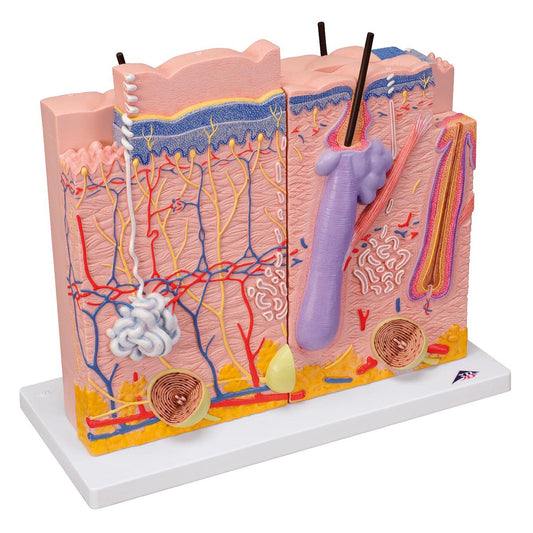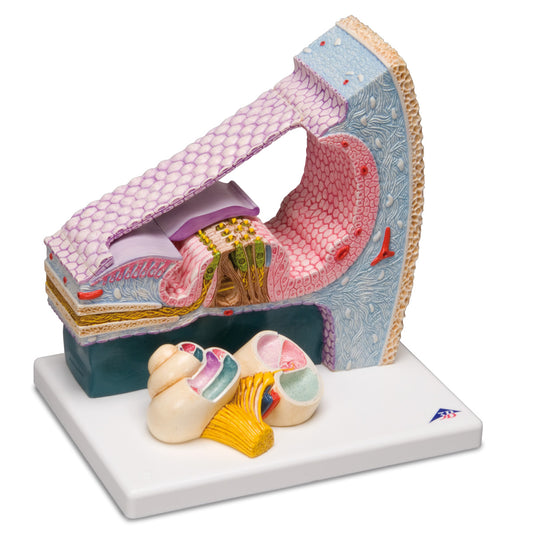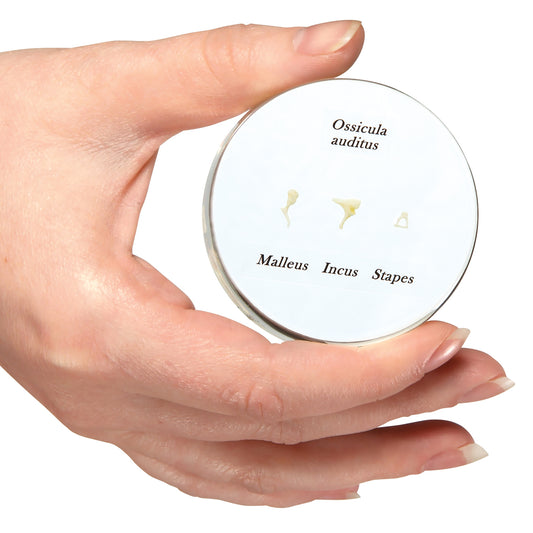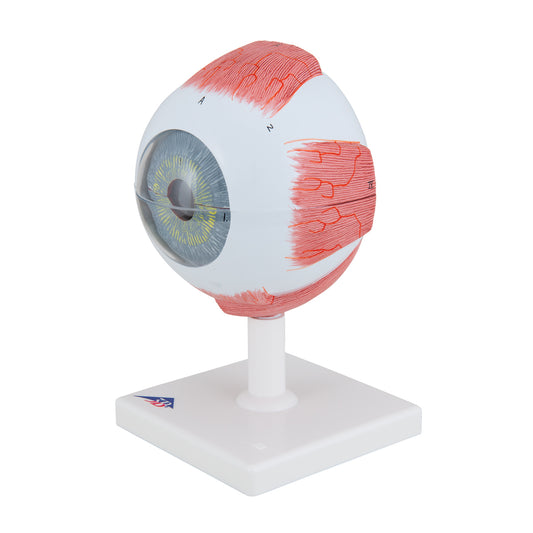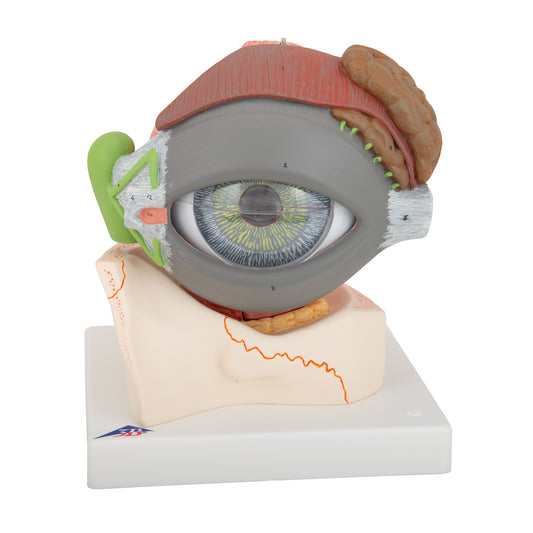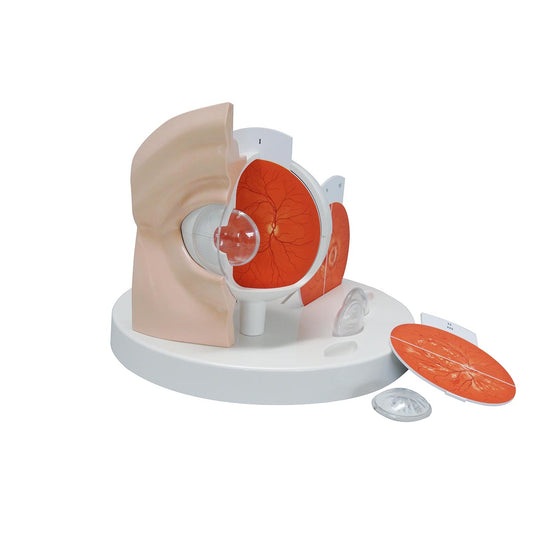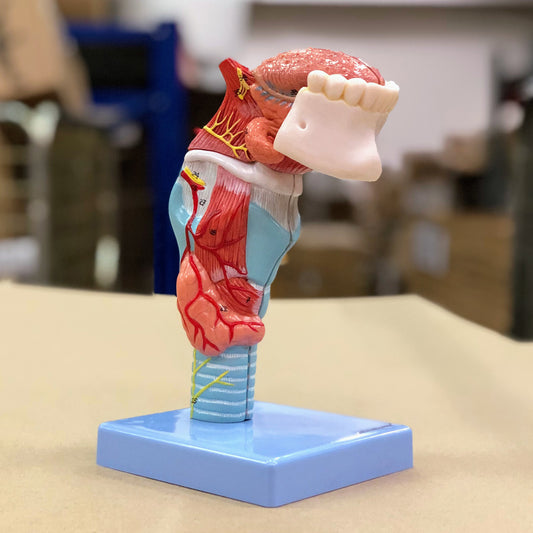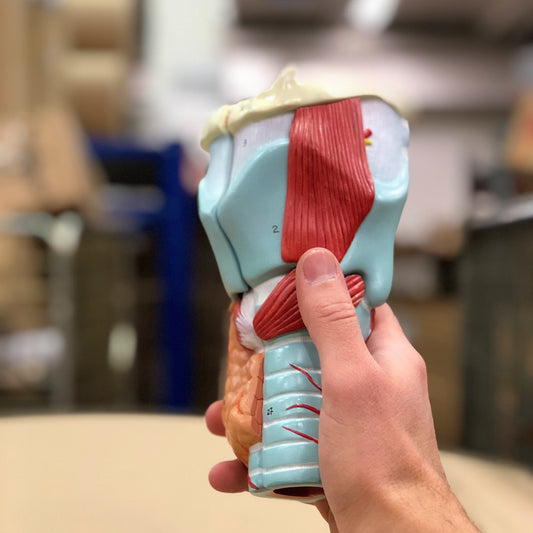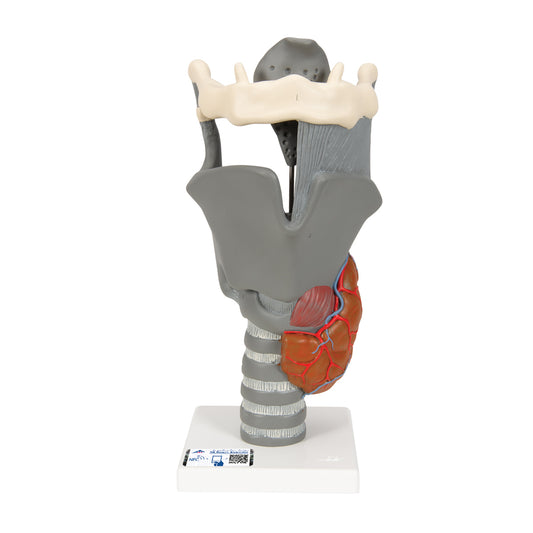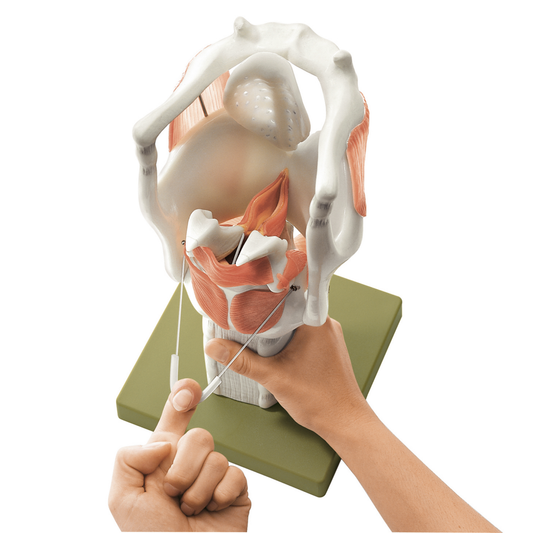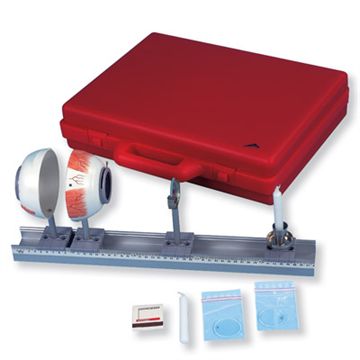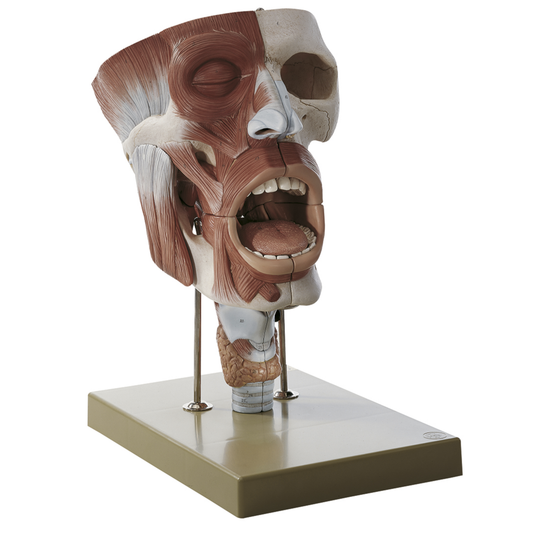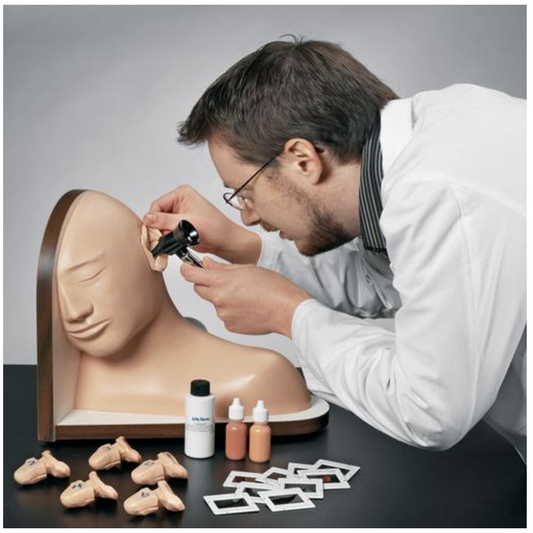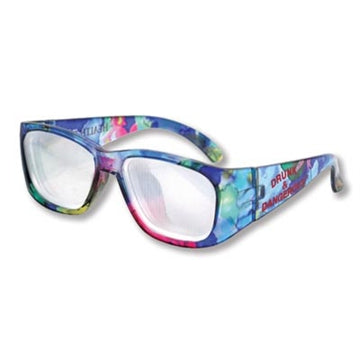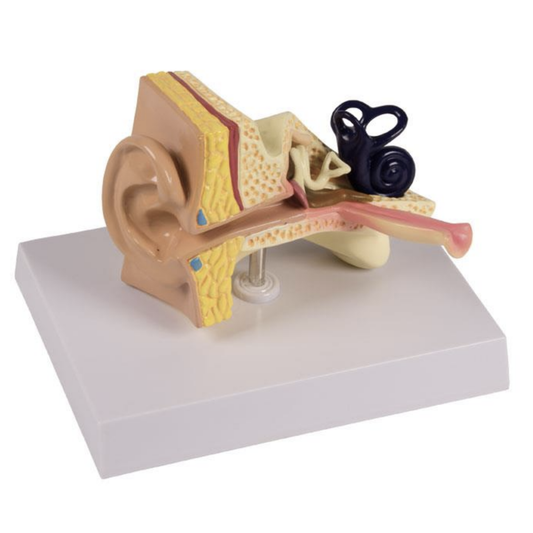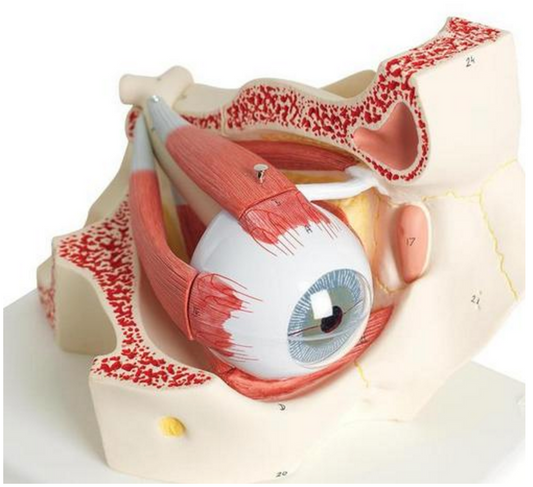Collection: The sense organs
-
Skin model of 3 skin areas. Can be separated into 3 parts
Regular price €300,95 EURRegular priceUnit price / per -
Skin model of one skin area
Regular price €88,95 EURRegular priceUnit price / per€153,95 EURSale price €88,95 EURSale -
Skin model of 2 skin areas, a nail and a hair root assembled on a stand
Regular price €106,95 EURRegular priceUnit price / per -
Very enlarged and detailed ear model which can be separated into 4 parts
Regular price €67,95 EURRegular priceUnit price / per€133,95 EURSale price €67,95 EURSale -
Very enlarged and detailed ear model which can be separated into 4 parts
Regular price €204,95 EURRegular priceUnit price / per -
Detailed ear model that shows both the entire cochlea and a cross-section with three-dimensional details
Regular price €324,95 EURRegular priceUnit price / per -
Life-size model of the 3 small bones of the middle ear
Regular price €61,95 EURRegular priceUnit price / per€140,95 EURSale price €61,95 EURSale -
Classic eye model which is enlarged and can be separated into 6 parts
Regular price €215,95 EURRegular priceUnit price / per -
Complete eye model which is enlarged and can be separated into 8 parts
Regular price €443,95 EURRegular priceUnit price / per€0,00 EURSale price €443,95 EUR -
Practical eye model which is enlarged and shows 11 eye diseases/disorders
Regular price €406,95 EURRegular priceUnit price / per -
Classic model of the 4 sinuses as well as oral cavity, nasal cavity and pharynx
Regular price €54,95 EURRegular priceUnit price / per -
Nose and throat model
Regular price €201,95 EURRegular priceUnit price / per -
Larynx model with vocal folds and several other tissues. Can be separated into 5 parts
Regular price €201,95 EURRegular priceUnit price / per -
Enlarged larynx model with vocal folds and several other tissues. Can be separated into 5 parts
Regular price €133,95 EURRegular priceUnit price / per -
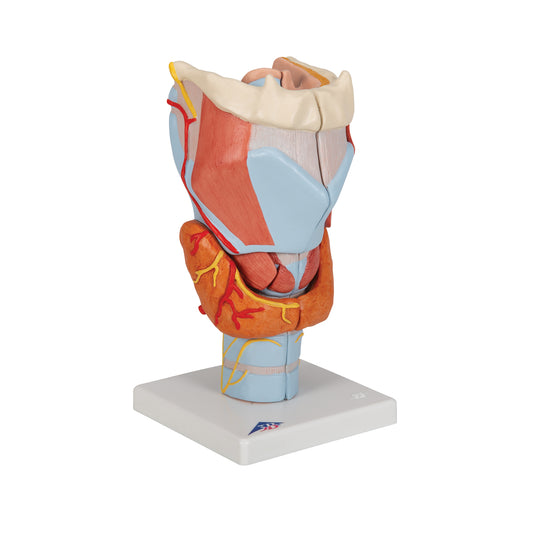

Enlarged larynx model with vocal folds and several other tissues. Can be separated into 7 parts
Regular price €216,95 EURRegular priceUnit price / per€350,95 EURSale price €216,95 EURSale -
Model of the larynx with movable nasal cartilages and epiglottis
Regular price €275,95 EURRegular priceUnit price / per -
Enlarged and particularly movable larynx model with vocal folds and relationships to several other tissues
Regular price €813,95 EURRegular priceUnit price / per -
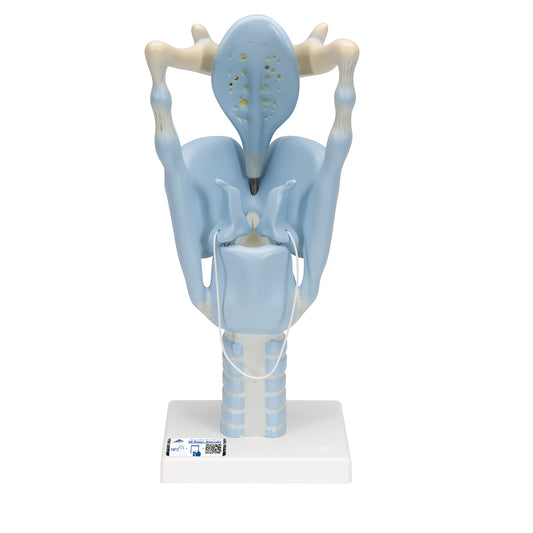
 Sold out
Sold outFunctional larynx in 3 x normal size
Regular price €367,95 EURRegular priceUnit price / per -
Practical eye model for demonstrating the refraction and refractive errors of the eye
Regular price €992,95 EURRegular priceUnit price / per -
Detailed model of nose, throat and throat in strong magnification
Regular price €3.867,95 EURRegular priceUnit price / per -
Simulator for training in ear examination
Regular price €2.046,95 EURRegular priceUnit price / per -
Educational glasses that simulate the visual changes caused by alcohol intoxication
Regular price €386,95 EURRegular priceUnit price / per -
Ear model of a child's ear showing otitis media
Regular price €102,95 EURRegular priceUnit price / per -
Eye model 3 x magnification in 7 parts
Regular price €357,95 EURRegular priceUnit price / per
Collapsible content
Read more about the product category here
We call this selection the sense organs. The models are often called sensory models and show the anatomy of organs/tissues that primarily relate to sensation. Furthermore, we have chosen to subdivide the sensory models into 3 groups: Eye models, ear-nose-throat models and skin models.
In the selection of eye models you will find both eye models with and without diseases as well as other things such as special glasses.
In the selection of ear-nose-throat models, you will find different ear models, nose models and throat models/throat models with and without diseases.
In the selection of skin models, you will only find models of the skin and skin diseases such as acne and skin cancer.
Models of sensory organs are especially used for understanding anatomy as well as clinical aspects such as diseases, examinations and treatment.
Anatomically speaking, all these models really include many different tissues.
Eye models include many small and complex anatomical structures. With an eye model of the eyeball at hand, you can study the 3 layers of the eye - the outer, middle and inner. The outermost layer is made up of the transparent cornea, which at the limbus is connected to the sclera (the white tendon covering the back 5/6). The middle layer (called the uvea) consists of the iris (rainbow) incl. the pupil, the corpus ciliare (the ciliary body) and the choroid (the choroid). The innermost layer is the retina.
On the eye models, the eye movement apparatus can be seen at the outer end (the eye muscles). It consists of 6 striated muscles - the 4 straight muscles called musculi recti and the 2 oblique muscles called musculi obliqui. Inside the eye models is the vitreous body (corpus vitreum), and at the back is the optic nerve (nervus opticus) in relation to blood vessels.
The eye models can be split so that the layers can be studied. Furthermore, the lens and the entire vitreous body can be removed. On the complete eye model, which also shows the surroundings of the eye, a bit of bone tissue, other soft parts such as ligaments and fatty tissue and the lacrimal apparatus, which consists of the lacrimal gland and lacrimal ducts (the tear ducts, the lacrimal sac and the lacrimal duct, of which only the latter is not visible), are visible.
Ear-nose-throat models also include many small and complex structures. With a model of the entire ear, one can study the outer ear (auricula) with the ear canal (meatus acusticus externus), the middle ear (cavum tympani) and the inner ear (auris interna/labyrinth), which contains the cochlea (cochlea) and the balance organ ( with the archways). In addition, a large or small part of the tuba auditoriva (the Eustachian tube) is seen, which communicates with the nasopharynx (upper part of the pharynx) and the location of the ear in the temporal bone (os temoporale).
The ear models also show details such as the eardrum (membrana tympani) and the 3 small bones of the middle ear (ossicula auditus, ossicula auditoria), which respectively called the hammer (malleus), the anvil (incus) and the stirrup (stapes).
The models also show some small muscles and blood vessels such as the internal carotid artery. The most detailed model of the entire ear is greatly enlarged and also shows details such as the oval window.
In the selection there is an ear model which only shows the 3 bones of the middle ear and a simulator for training in ear examination. In addition, there are 2 ear models which show the small anatomical structures in the cochlea, where sensory cells register oscillations which, via nerve connections, lead to sound perception in the brain. One model is a gigantic model of these structures - the other model is smaller and shows far more detail. The 2 models show a cross-section through the ductus cochlearis with the scala vestibuli and scala tympani respectively. over and under. Centrally, the membrana basilaris is seen, which is set into resonant oscillations in connection with hearing. These oscillations are registered by the complex system of sensory cells (the cortical organ/organum spiral) which is attached to the basilar membrane.
Both ear models of the cochlea show structures such as the membrana tectoria, membrana vestibularis (Reissner's membrane), cuniculus internus (the cortical tunnel), ligamentum spiral and cochlear nerve fibers. The model with the most detail of the structures in the cochlea also shows details such as ganglion spiral and many specific cell types such as Hensen cells, Claudius cells and Böttcher cells.
In these ear models (cochlear models/models of the cochlea), the cochlear nerve, which is the auditory nerve, can be seen. It is a component of the vestibulocochlear nerve (8th cranial nerve/cranial nerve which is also called the nerve of hearing and equilibrium). Nervus vestibularis (nerve of balance) is the second component of the 8th cranial nerve.
The nasal models/sinus models/sinus models include small and complex anatomical structures. With a nose model in hand, you can study the nasal cavity (cavum nasi), part of the oral cavity (cavum oris), a little of the pharynx (pharynx) and the sinuses (frontal sinus, sphenoidal sinus, maxillary sinus and ethmoidal sinus ). The sinus models also show the 3 concha bones of the nose (concha nasalis superior, media and inferior). One sinus model also shows the olfactory nerve.
With the tongue model in hand, you can study the musculature of the tongue, the upper side with the 4 papillae (papillae vallatae, papillae filiformes, papillae fungiformes and papillae foliatae), a bit of the lower jaw bone (mandible) with teeth and 2 of the 3 oral salivary glands (glandula submandibularis and glandula sublingualis) .
The 3 throat models/neck models primarily show the throat/larynx (larynx) with laryngeal cartilage, laryngeal muscles, vocal folds (plicae vocales), the epiglottis, the 2 joints called articulatio cricothyroidea and articulatio cricoarytenoidea as well as the transition to the windpipe (trachea). On 2 of the neck models, the thyroid gland (gl. thyroidea), one or more of the parathyroid glands (glandulae parathyroidea) and vascular and nerve supply can also be seen. On the 2 latter models, the throat (pharynx) can be seen, although it is not defined.
The larynx model at the highest price is, unlike the other 2, movable in the joints of the larynx and can thus be used to understand how the length, tension and mutual distance of the vocal cords are regulated.
Skin models include the skin's 2 layers (the epidermis/epidermis and the dermis) as well as a bit of the subcutis. On several of the models, you can also study the layered structure of the epidermis, which consists of the stratum basale, stratum spinosum, stratum granulosum, stratum lucidum and stratum corneum.
All the skin models show important structures in the dermis such as blood vessels, hair follicles with attached smooth muscle (m. arrector pili) and sweat and sebaceous glands. Some of the models also show encapsulated (afferent) nerve endings such as Meissner corpuscles and Pacini corpuscles.
One of the skin models also shows a nail and a root of hair. The model shows the hair root with medulla, cortex and hair cuticle as well as a nail with associated nail bed.
On all the models, a bit of the subcutaneous tissue is also shown in yellow at the bottom. This symbolizes fat cells (as the subcutaneous tissue mainly consists of fat cells).
Clinically, the eye models can be used to understand diseases of the eye. It can be, for example, "red eye", retinal detachment, vitreous collapse, diabetic eye disease, uveitis, scleritis as well as metastases and primary tumors such as malignant melanomas (birthmark cancer) in the uvea.
The complete eye model can also be used to understand diseases of the lacrimal gland and tear ducts, such as lacrimal duct stenosis. The practical eye model can be used to demonstrate and understand the representation of objects on the retina, accommodation (via changes in the curvature of the lens), nearsightedness (myopia) and farsightedness (hypermetropia).
An ear model/plastic ear, on the other hand, can be used to understand disorders and diseases in the various tissues/structures of the ear. It can be, for example, otitis media, cholesteatoma (bone eating), perforated eardrum and myringitis bullosa. The models that show tissue in the cochlea can be used to understand disease, damage or congenital deformity in the hair cells of the cochlea as well as cochlear implantation.
A nose model/sinus model/sinus model can be used to understand disorders/diseases such as sinusitis (sinusitis) and nasal polyps as well as treatments such as surgery of the nasal concha (conchotomy). The tongue model can be used to understand diseases/disorders in the tongue such as fissured tongue, infections and cancer.
A larynx model/neck model can be used to understand many disorders such as epiglottitis, vocal cord polyps, goiter, laryngeal edema and cancers. Furthermore, the throat model can be used to understand examination methods such as laryngoscopy and treatments such as throat surgery. If the joints of the throat are flexible on the model, it can also be used to demonstrate movements.
In conclusion, a skin model can be used to understand skin disorders and skin diseases such as psoriasis, folliculitis, acne and skin tumors. Furthermore, they can be used to understand other things, such as burns, which are traditionally divided into degrees (1st degree, 2nd degree, etc.).
The acne model has been developed to understand acne vulgaris (pimples/blackheads), which is inflammation of the sebaceous glands. The model also shows comedones.
The skin model of mole cancer (malignant melanoma) in different stages, on the other hand, has been developed for understanding this malignant skin cancer.

A window to a world of anatomy
Whatever you're looking for
Then we can procure or produce it. eAnatomi is more than just a retailer of existing products. We have our own development department, where we create unique and original products that are used for training, guidance and inspiration.

19 years of anatomy
A safe transaction
For 19 years I have been at the head of eAnatomi and sold anatomical models and posters to 'almost everyone' working with anatomy in Denmark and abroad. When you do business with eAnatomi, you do business with me and I personally guarantee a safe transaction.
Christian Birksø
Owner and founder of eAnatomi
Latest blog news
View all-

2 meter tall anatomy figures - we call it anato...
For more than a decade, eAnatomy has produced our own anatomical illustrations, performed by the best illustrators. Where most illustrations are used on classic printed media such as posters, selected...
2 meter tall anatomy figures - we call it anato...
For more than a decade, eAnatomy has produced our own anatomical illustrations, performed by the best illustrators. Where most illustrations are used on classic printed media such as posters, selected...
-

Anatomical Chart Company - changes the format
Anatomical Chart Company har i 2023 besluttet af udfase papirvarianten for fremover kun at levere den let laminerede version med ringhuller. Dette betyder at det ikke længere bliver muligt, at...
Anatomical Chart Company - changes the format
Anatomical Chart Company har i 2023 besluttet af udfase papirvarianten for fremover kun at levere den let laminerede version med ringhuller. Dette betyder at det ikke længere bliver muligt, at...
-
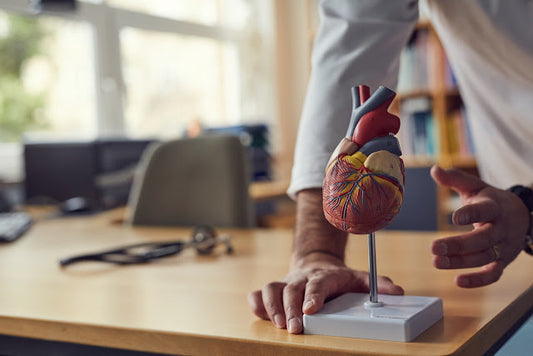
The heart model's place in teaching & expla...
Teachers, professionals and other mediators can easily be challenged when they have to explain the anatomy and diseases of the heart.
The heart model's place in teaching & expla...
Teachers, professionals and other mediators can easily be challenged when they have to explain the anatomy and diseases of the heart.

